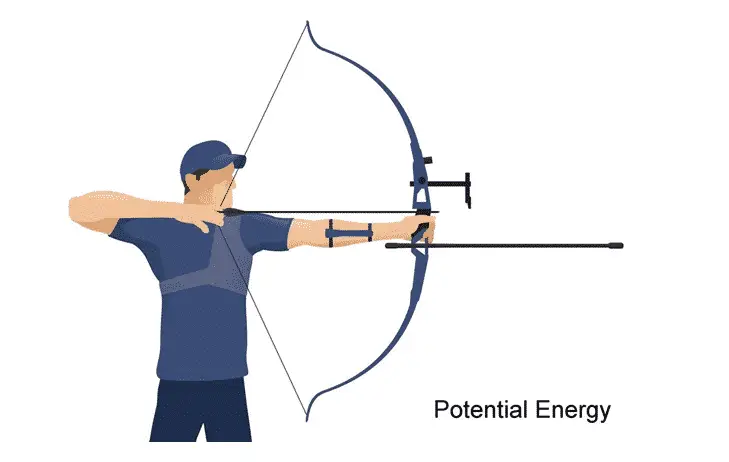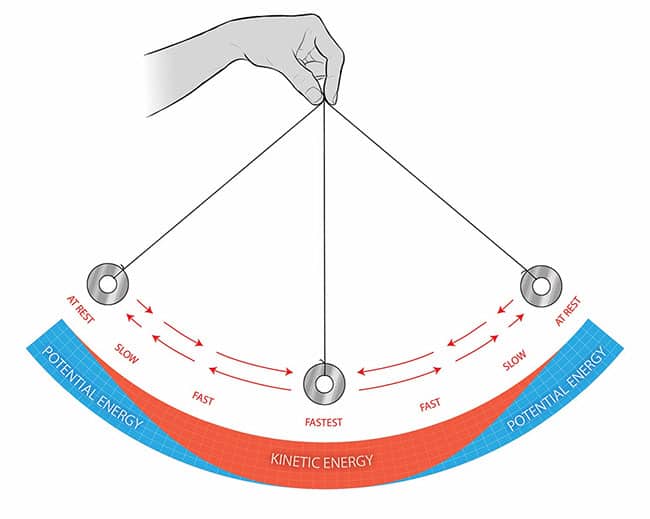According to physical science, there are many forms of energy that exist in nature like magnetic energy, chemical energy, nuclear energy, electrical energy, and, so on. But, they all fall into two basic categories. These are kinetic and potential energy. Just because of the demand for the topic, today, we are only interested in these two. So, what is the difference between kinetic and potential energy?
The primary difference between kinetic and potential energy is that kinetic energy is the energy of motion and potential energy is the energy of position. Not to mention, in this exclusive article, I am going to get through each and every detail regarding these two. But, before going into the deep discussion, let me give you a brief review of the two in a tabular form. Let’s dive right in!!!
Difference Between Kinetic and Potential Energy
| Kinetic Energy | Potential Energy | |
| 1. | Kinetic energy is the energy of motion. | Potential energy is the energy of position. |
| 2. | By the process of collision, kinetic energy can be easily transferred from one body to another. | There is no way to transfer potential energy from one body to another. |
| 3. | Kinetic energy can be easily converted into any other form of energy including potential energy. | Potential energy can be easily converted into any other form of energy including kinetic energy. |
| 4. | Kinetic energy is a scalar quantity. | Potential energy is also a scalar quantity. |
| 5. | Types of kinetic energy include translational kinetic energy, rotational kinetic energy, and vibrational kinetic energy. | Types of potential energy include gravitational potential energy, elastic potential energy, chemical potential energy, and so on. |
| 6. | Both kinetic and potential energy constitute mechanical energy. | Both kinetic and potential energy constitute mechanical energy. |
| 7. | The formula for kinetic energy is ½mv². | The formula for potential energy is mgh. |
| 8. | Similarly, the S.I. unit of potential energy is also Joule. | Similarly, the S.I unit of potential energy is also Joule. |
| 9. | A ceiling fan in your house is the perfect example of kinetic energy. | A car at the top of the mountain is the perfect example of potential energy. |
What is Kinetic Energy?

According to the definition of kinetic energy, the energy possessed by an object or body by virtue of its motion is known as kinetic energy. In other words, when an object is in momentum (motion), it has energy in the form of kinetic energy.
In fact, not only the motion ( speed or velocity) of an object is responsible for the kinetic energy. The mass of an object also plays a very constructive role. Therefore, one can say that both speed and mass of the object are the determining factors for kinetic energy.
Moving ahead, the SI of kinetic energy is Joule which is equal to kg m²/s². Additionally, Kinetic energy is a scalar quantity. In other words, it does not have any direction. It only has magnitude. The formula for kinetic energy is ½mv².
Check out: Difference Between Scalar and Vector Quantity (Tabular Form)
Types of Kinetic Energy
Based on the type of motion a body or object has, we can categorize kinetic energy into three different sections. Let’s take a look at them one by one. Therefore, keep reading!
Translational Kinetic Energy
Translational kinetic energy is the type or form of kinetic energy due to the straight-line motion of a body or an object. A train running on a track is the perfect example of translational kinetic energy.
Rotational Kinetic Energy
Rotational kinetic energy is the type or form of energy due to the rotational motion of the body or an object. An electron rotating around the nucleus is the perfect example of rotational kinetic energy.
Vibrational Kinetic Energy
Vibrational kinetic energy is the type or form of energy due to the vibrational motion of the body or an object. The vibration of your cell phone is the perfect example of vibration kinetic energy.
Must read: What is Kinetic Energy? – Definition, Types & Examples
Characteristics of Kinetic Energy
There are so many essential features or characteristics of kinetic energy. Some of them are listed below.
- Kinetic energy is the energy of motion.
- It can be easily converted to any other form of energy.
- kinetic energy is directly proportional to the mass and speed (velocity) of the body.
- With the process of collision, it can be easily transferrable from one body to another, etc.
Check Out: Top 6 Uniform Motion Examples in SIX minutes (All NEW)
Kinetic Energy Examples in Daily Life
If you think you can’t relate to kinetic energy examples in everyday life. Well, here is your chance to think again!
- An Electron revolving around the nucleus has kinetic energy.
- A bullet fired from the gun has kinetic energy.
- The kinetic energy of a fast stream of water is used to run water mills.
- Any object that is freely falling due to gravity has kinetic energy.
- The kinetic energy of air is used to run the wind turbines.
- The earth revolving around the sun has kinetic energy, etc.
Editor’s Choice: Difference Between Uniform and Non-uniform Motion with Examples
What is Potential Energy?
According to the definition of potential energy, the energy possessed by an object due to its position is known as potential energy. In other words, the energy that is stored is called potential energy.
Moving ahead, the S.I. unit of potential energy is Joule which is equal to kg m²/s². Additionally, potential energy is also a scalar quantity. The formula for potential energy is mgh.

Not to mention, apart from the position of the body, there are some other factors too. In general, it is the energy held by an object not only because of its position relative to other objects. But also because of the stresses within itself, its chemical composition, its electric charge, or some other factors.
In fact, based on these factors that affect the potential energy of an object, it can be further dissected into several parts. Let’s talk about the different types of potential energy in the next section. Therefore, keep reading.
Must read: Nuclear Fission vs Nuclear Fusion – Difference in Tabular Form
Type of Potential Energy
There are so many types of potential energy such as magnetic potential energy, electric potential energy, nuclear potential energy, chemical potential energy, and many more.
Out of all, I will be discussing two of the most common types of potential energy. Let’s get to know both of them one by one in detail. Keep reading!
Editor’s Choice: Difference Between Renewable and Nonrenewable Energy Resources
Gravitational Potential Energy
Gravitational potential energy is the type or form of potential energy due to the mass of an object and the vertical height to which it is raised with respect to another massive object. A glass kept on the table is the perfect example of gravitational potential energy.
Elastic Potential Energy
Elastic potential energy is the type or form of potential energy due to the elasticity of an object. An archer’s stretched bow is the perfect example of elastic potential energy.
Related: What is Potential Energy? – Definition, Facts, Types & Examples
Characteristics of Potential Energy
There are so many essential features or characteristics of potential energy. Some of them are listed below.
- Potential energy is the energy of position.
- Just like kinetic energy, potential energy can also be easily converted to any other form of energy.
- Potential energy is directly proportional to the mass and height of the body.
- It can never be transferred from one body to another, etc.
Potential Energy Examples in Daily Life
If you think you can’t relate to potential energy examples in daily life. Well, here is your chance to think again!
- The water behind the dam has gravitational potential energy.
- Firecrackers have chemical potential energy.
- A stretched bow has elastic potential energy.
- A book on a table has gravitational potential energy.
- Similarly, a child at the top of the slide has gravitational potential energy.
- The battery has chemical potential energy.
- An atom has nuclear potential energy, etc.
What is the relationship between kinetic and potential energy?
The primary relationship between kinetic and potential energy is their ability to easily transform into each other. Not to mention, they both are the sole constituent of mechanical energy.
In other words, the sum of kinetic and potential energy is mechanical energy. Let’s take an example to understand how easily they can transform into each other.
Physics of Pendulum
I am quite sure that you know what a pendulum is and what it does i.e. swing back and forth!!! A pendulum is a mechanical system that works due to the continuous exchange of kinetic and potential energy.

By moving back and forth, the mechanical system of the simple pendulum has both kinetic and potential energy which is constantly changing between the two.
That, when the bob of the pendulum is at rest or extreme position, it has the maximum potential energy and minimum kinetic energy. (See the above image for proper understanding).
Related: Top 6 Sources of Mechanical Energy You Should Know
On the other hand, when the bob is at the vertical or mean position, it has the maximum kinetic energy and minimum potential energy.
That’s it for this post. If you like this article, share it if you like, and like it if you share it. You can also find us on Mix, Twitter, Pinterest, and Facebook. Hey man, If you have come this far, do give us feedback in the comment section. It would make my day. You can also make a donation. Your donations will help us to run our website and serve you BETTER. Cheers!!!
You might also like:
- Difference Between Conductors and Insulators in Tabular Form
- Difference Between Distance and Displacement (Tabular Form)
- Volt vs Ampere – Difference and Comparision
- Difference Between Periodic and Non-periodic Motion in Tabular Form
- Top 6 Different Types of Energy with Their Examples (All New)
- Top 6 Non-uniform Motion Examples in SIX Minutes
- Difference Between Speed and Velocity in Tabular Form
- Difference Between Balanced and Unbalanced Forces (Tabular Form)
